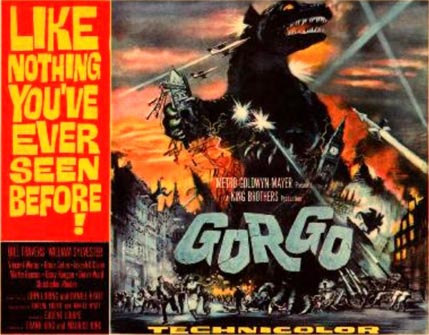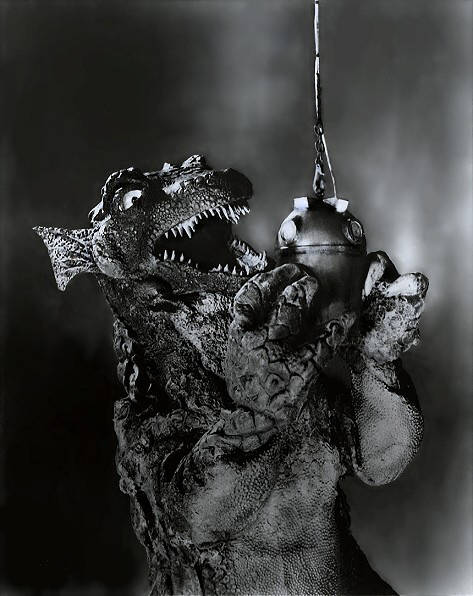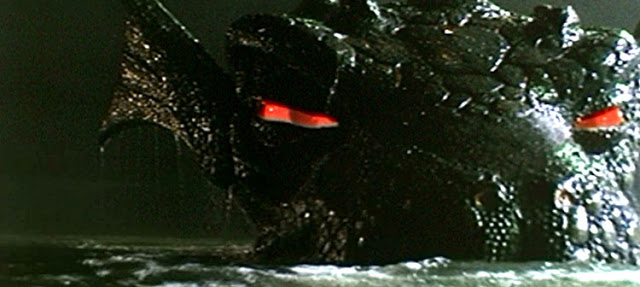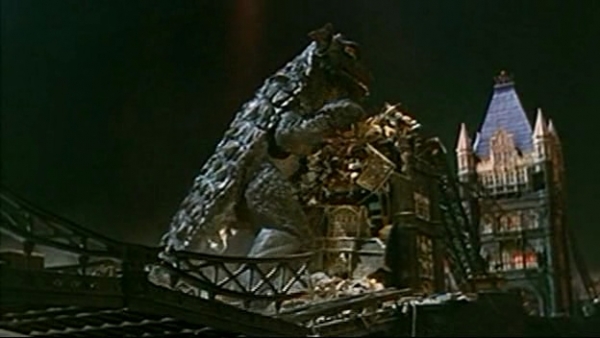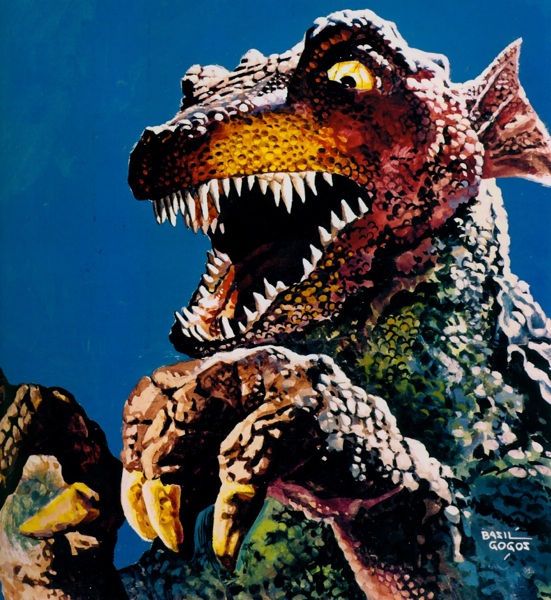Gorgo is probably the best movie ever to appear on Mystery Science Theater 3000.
It’s still fun to poke at its various moments of silliness and overuse off stock footage towards the end of Act 2.
However, it’s still a decent movie with a memorable monster and sound track.
Gorgo is the best example of a true Western Kaiju, right down to being performed by a man in a suit.
It even keeps the proper symbolism of a Kaiju and carries it through its best known media tie in—comics drawn by Steve Ditko. If that’s not enough of a moment of weirdness, that comic also featured an unaccredited cameo by Reptilicus!
Gorgo’s symbolism starts with the origins of the concept.
Like Godzilla, Gorgo traces his roots to The Beast from 20,000 Fathoms but for entirely different reasons. This is probably because the films share a director, Eugène Lourié. After watching Beast with his daughter, he found her rather distraught. She was rather upset that the beast had to die.
Given the Pathos which Ray Harryhausen gave it, it’s unsurprising to us now, but to him it was a bit of a shock. Almost a decade later, he got his chance to give his daughter what she wanted. The mother monster in this film is honestly the most heroic character in it.
This little story was not brought up during its run, but came out later. During the run, however, the producers at King Brothers proclaimed that they received a lot of motherly support for this picture. Given the story is of the ultimate “Mother Bear” archetype rescuing its offspring, it makes sense.
Like a proper Kaiju, Gorgo’s mother (“Ógra” by the fans, after the old Irish mythical name they conjured for, it’s usually written as “Ogra” in the west, it is actually the Gaelic word for “Youth”) retains the core concept of a Kaiju: being an unstoppable force of nature. With that, though is what I mentioned earlier – a mother’s love for her offspring.
Because of this mother’s instinct, it turns the entire film completely on its head, which adds to the key elements that, overall, make it unlike any other giant monster movie yet produced.
If it wasn’t for the fact that Ógra is the only female character with any importance (and almost at all if it wasn’t for crowd shots) in the entire movie, I’d almost call this mildly feminist in nature, with a very nature oriented female lead clashing directly against a patriarchal society that has violated the sacred bond between mother and offspring.
But that would be reading WAY too much into it, even if there were other female characters in the movie itself.
The actual subtext of the film has more to do with the fact that both the mother and the monster are Irish. The history of Ireland and Britain is a tense one, especially up in the north. And the story of a young Irish “man” being taken in chains down to London to be gawked at, where all official objections from the Irish people are ignored. Then having “Mother Ireland” (THE personification of Ireland amongst the Irish) coming to its rescue and smashing the key symbols of British power (London, the Tower Bridge, Big Ben) has a bit of bite to it.
Biology
It almost goes without saying, but the standard rule of Kaiju (armored like a mountain just to stand upright) applies to Gorgo as well as the other giant monsters talked about so far this summer. The size difference between Gorgo and his mother does raise the question of if Gorgo was born live or hatched from an egg. The size differential would seem to indicate an egg, but live is still possible. Also given the size difference, it is unlikely that it was the only one born initially. It could be the last off the clutch, which would certainly add to the mother’s protective instincts.
Gorgo’s primary motivating factor of motherly affection/aggression is something that is normally applied to mammals and may seem out of place for a reptilian horror. But not all reptiles abandon their offspring. Crocodilians and their cousins in Dinosaurs and Birds, care for their young in various ways. Footage exists of crocodiles actually feeding their young in a manner similar to birds. And the guarding of their nests is well documented. Extending that protectiveness further is not that much of a stretch.
Though it does raise the question of how the young Gorgo managed to be captured in the first place. That, thankfully, has an easy explanation and adds to the likely intelligence of the monster: It was curious and wandered off. It happens to many animals. Often, they are sojourns to find food on their own and can land them in trouble with predators.
Beyond this instinct and its overwhelming presence in the film, Gorgo and its mother appear to be dinosaurs—they have the right ankles and everything. Large, semi-aquatic dinosaurs (Spinosaurs) are not unknown, but they are specialized fish eaters with narrow snouts and heavy claws. The shape of Gorgo’s jaw indicates a different feeding style. At first, it appears to be reminiscent of an American alligator, their broad heads designed to eat meatier targets than fish such as deer, turtles and pretty much whatever they come across. The heavy claws, reminiscent of the dinosaur Baryonyx, would be perfect for catching large fish (or, in Gorgo’s case, whales).
However, Gorgo’s teeth are long, pointed and thin. This would indicate a fish-related diet. Given these two contradictory elements, it is more likely that Gorgo is actually a filter feeder. Eating and feeding like large whales, gulping schools of medium-to-small fish from cod to herring, and probably krill as well.
The next point that should be brought up: Gorgo and Ógra have heavy armor on their back. The first instinct might be to think of them as defenses against predators—but the adult Gorgo is over 200ft tall. Not much can prey on that besides other Kaiju or other members of its species. Alligators too are heavily armored animals, mostly to deal with fights amongst themselves: males for territory and mates, females for territory and nesting privileges.
The final bit of behavioral notation comes from the fins on either side of the animal’s head. They appear to be for minor displays of emotion between species, like a smile or frown would with a human. Here, there’s only one display readily apparent – when the ‘ears’ flap, the animal is agitated or upset.
Both of which are really unsurprising emotions for a mother desperately trying to reclaim her offspring to express.







































































































